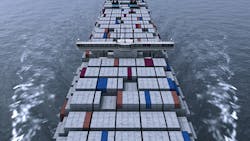Advent of Super Cargo Ships 'Makes No Sense' Right Now
Import cargo volume at the nation’s major retail container ports should see its traditional buildup toward the summer despite difficult comparisons with last year’s unusual patterns, according to the monthly Global Port Tracker report from the National Retail Federation and consulting firm Hackett Associates.
“Comparisons are still complicated because of last year’s situation at the West Coast ports but should clear up in the second half of the year,” says Jonathan Gold, NRF’s vice president for supply chain and customs policy. “Year-over-year numbers are skewed but on a monthly basis imports are building normally as the back-to-school season approaches.”
Ports covered by Global Port Tracker handled 1.5 million twenty-foot equivalent units (TEUs) in January, the latest month for which after-the-fact numbers are available. That was up 4.4% from December and 21.4% from unusually low figures in January 2015, the month before a new contract with dockworkers was signed to end a near-shutdown at West Coast ports.
February was estimated at 1.4 million TEUs, up 17.1% from the same month in 2015 and also skewed by last year’s congestion. March is forecast at 1.35 million TEUs, down 22.2% from the flood of traffic seen as the backlog of cargo began to move through ports at this time last year. April is forecast at 1.49 million TEUs, down 1.8% from last year; May at 1.56 million TEUs, down 3.4%; June at 1.54 million TEUs, down 1.6%; and July at 1.61 million TEUs, down 0.4%.
The first half of 2016 is expected to total 8.8 million TEUs, down 0.2% from the same period in 2015. Total volume for 2015 was 18.2 million TEUs, up 5.4% from 2014.
With cargo volume down so far this year, Hackett Associates’s founder Ben Hackett says recent decisions by major shipping lines to add new super-large capacity vessels to routes between Asia and the U.S. West Coast are likely to bring lower shipping rates at the risk of “chaos” in the balance between supply and demand.
“Does this make sense? Absolutely not,” Hackett says. “It flies in the face of financial and economic wisdom and totally ignores the state of the freight market.”
Global Port Tracker, which is produced for NRF by Hackett Associates, covers the U.S. ports of Los Angeles/Long Beach, Oakland, Seattle and Tacoma on the West Coast; New York/New Jersey, Hampton Roads, Charleston, Savannah, Port Everglades and Miami on the East Coast, and Houston on the Gulf Coast.
